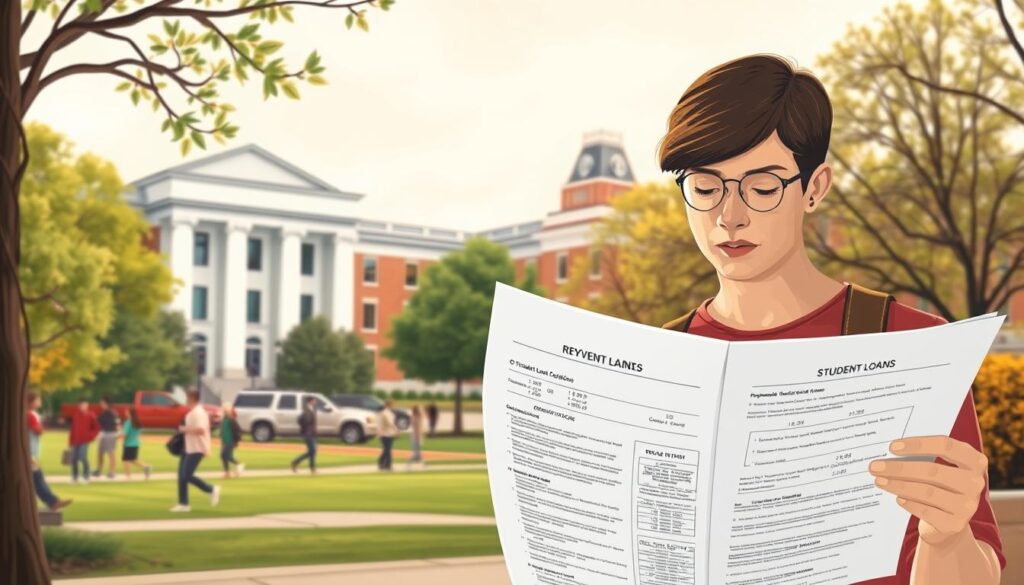Financing Your College Education: Explore College Loans
Did you know that the Consumer Financial Protection Bureau suggests saving, grants, scholarships, and federal student loans first for college funding? This strategy helps in choosing the right financial aid options.
It’s important to know about the financial aid choices available. We’ll help you understand your options and make smart choices for your higher education funding.
Exploring these options can help you manage the complex education financing process better.
Key Takeaways
- Prioritize savings, grants, and scholarships before considering loans.
- Understand the different types of federal student loans available.
- Evaluate your financial options carefully to make informed decisions.
- Consider the implications of different financial aid options.
- Seek guidance to navigate the complex process of financing higher education.
Understanding College Loans: An Overview
Financing your college education starts with knowing about college loans. As college costs keep going up, many students and families use student loans to help out.
College loans help pay for things like tuition, fees, and living costs. There are different kinds of loans, each with its own benefits and rules.
What Are College Loans?
College loans let students borrow money for school. Unlike grants or scholarships, you have to pay them back, usually with interest. The details of these loans can change a lot, depending on who you borrow from and what kind of loan it is.
Sallie Mae, a big name in student loans, offers many loan choices for undergrad and grad students. These loans can have different rates and repayment plans. It’s key to know what you’re getting into.
Types of College Loans
There are many student loans out there for college students. You can get federal loans, private loans, or loans from colleges themselves. Each has its own good points and rules.
Federal student loans come from the government and often have better terms, like lower interest rates and flexible repayment plans. Private student loans, on the other hand, are from banks and other lenders, and their terms can vary a lot.
| Loan Type | Interest Rate | Repayment Terms |
|---|---|---|
| Federal Loans | Fixed, typically lower | Flexible, income-driven plans available |
| Private Loans | Variable or Fixed, potentially higher | Varies by lender, less flexible |
Federal vs. Private Loans
Choosing between student loans is a big decision. Federal student loans are often better because of their protections and flexible repayment plans.
“Federal student loans offer a range of benefits, including fixed interest rates and income-driven repayment plans, making them a more attractive option for many students.”
Private student loans might let you borrow more, but they usually have less favorable terms. It’s important to think about things like interest rates, repayment plans, and benefits for borrowers carefully.
Knowing the differences between federal and private loans helps students make smart choices about college money. We’ll look at more ways to handle student loans in the next parts.
How to Apply for College Loans
To fund your education, understanding how to apply for college loans is key. The process includes steps for federal loan applications and requires specific documents.
Steps for Federal Loan Application
Starting with federal college loans means filling out the Free Application for Federal Student Aid (FAFSA). This form is vital as it shows if you qualify for federal, state, and school financial aid.
- Create an FSA ID to access and sign your FAFSA.
- Gather necessary financial documents, such as tax returns and social security numbers.
- Complete the FAFSA form accurately and submit it by the deadline.
- Review your Student Aid Report (SAR) for accuracy.
After you submit your FAFSA, your info will be reviewed. You’ll get a Student Aid Report. Then, your school will figure out your financial aid package, which might include federal loans.
Essential Documents Needed
To apply for college loans, you’ll need a few key documents. The most important is the FAFSA. You might also need:
- Tax returns and W-2 forms.
- Social security number or Alien Registration number.
- Driver’s license or state ID.
- Records of untaxed income, if applicable.
Having these documents ready can make your application smoother.
It’s also important to know about loan repayment options. Federal loans offer different repayment plans. These include income-driven plans that adjust based on your income and family size.
| Repayment Plan | Description | Eligibility |
|---|---|---|
| Standard Repayment Plan | Fixed monthly payments for up to 10 years. | All federal loan borrowers. |
| Income-Based Repayment (IBR) Plan | Monthly payments based on income and family size. | Partial financial hardship. |
| Pay As You Earn (PAYE) Plan | Monthly payments based on income and family size, with forgiveness after 20 years. | Partial financial hardship, newer borrowers. |
Also, borrowers should look into loan consolidation options. Consolidating loans can make repayment easier by combining multiple loans into one with a single interest rate and monthly payment.
Interest Rates for College Loans
It’s key to know the interest rates on college loans. This is important for students and their families. The rate can change how much you pay back over time.
When looking at private student loans, you’ll see two main types of rates: variable and fixed. Variable interest rates can go up or down with the market. Fixed interest rates stay the same, so your payments won’t change.
Variable vs. Fixed Rates
Choosing between variable and fixed rates depends on your financial situation and risk comfort. Sallie Mae offers both. A variable rate might start lower but could go up. A fixed rate means your payments stay the same.
How Interest Rates Are Determined
Interest rates are based on your credit score, the loan type, and market conditions. Lenders like Sallie Mae use these to set your rate. Usually, better credit scores mean lower rates.
Knowing how rates are set helps you choose wisely. Look at your credit score and compare loans. This could lead to a lower rate and less overall cost for your education.
Repayment Plans for College Loans
Borrowers have many repayment plans for college loans. Each plan has its own benefits and rules. Knowing these options helps manage payments and avoid default.
The Consumer Financial Protection Bureau says there are income-driven plans for federal loans. These plans can greatly affect a borrower’s financial future.
Standard Repayment Plan
The Standard Repayment Plan is the default for many. It has fixed monthly payments for 10 years for federal loans. It’s good for those who can afford it, as it pays off faster and less interest is paid.
For example, a $30,000 loan at 4% interest would cost about $303 monthly. Looking into other options can help find the best plan for your finances.
Income-Driven Repayment Options
Income-Driven Repayment (IDR) plans adjust payments based on income and family size. They’re great for those facing financial struggles. There are several IDR plans, like Income-Based Repayment (IBR) and Pay As You Earn (PAYE).
For example, IBR caps payments at a certain percentage of discretionary income. This can greatly lower payments for those in tough financial spots.

| Repayment Plan | Monthly Payment | Repayment Period | Eligibility |
|---|---|---|---|
| Standard Repayment Plan | Fixed | Up to 10 years | Most federal loans |
| Income-Based Repayment (IBR) | Income-dependent | 20 or 25 years | Partial financial hardship |
| Pay As You Earn (PAYE) | Income-dependent | 20 years | Partial financial hardship, newer loans |
Understanding the different repayment plans helps borrowers make smart choices about their loans. It’s key to know the rules and benefits of each plan to choose wisely.
Tips for Managing College Loan Debt
Tuition fees keep going up, making it crucial to manage college loan debt well. It’s key for financial stability after graduation. We’ll look at practical tips to help students handle their loan obligations.
Budgeting for Loan Payments
First, make a budget that includes loan payments. Knowing your financial duties helps you plan better. Finaid’s financial aid calculators can help figure out your monthly payments.
When budgeting, split your expenses into needs and wants. This helps find areas to cut back. You can then use that money for your loan payments.
Refinancing Options
Refinancing your college loans can simplify your debt. It might also lower your interest rates. This can make your monthly payments smaller and easier to manage.
Look into different refinancing options carefully. Some lenders offer flexible repayment terms and competitive rates. These can greatly improve your financial situation.
“Refinancing can simplify your finances by combining multiple loans into one loan with a single interest rate and monthly payment.”
| Refinancing Option | Interest Rate | Monthly Payment |
|---|---|---|
| Loan Consolidation | 4.5% | $200 |
| Private Refinancing | 3.75% | $180 |
| Federal Refinancing | 4.0% | $190 |
By using tools like Finaid’s financial aid calculators and looking into refinancing, students can manage their college loan debt well.
The Importance of Credit Scores
Credit scores are key when it comes to college loans. They affect the terms and conditions of these loans. Sallie Mae says credit scores are crucial for private student loans.
How Credit Scores Affect Loan Eligibility
A good credit score can lead to better loan options. This includes lower interest rates and more flexible repayment terms. For private student loans, lenders look at credit scores to gauge risk.
A higher score means less risk, leading to better loan terms.
Key factors that influence credit scores include:
- Payment history
- Credit utilization
- Length of credit history
- Credit mix
- New credit inquiries
Improving Your Credit Score
Improving your credit score takes effort. It’s important to check your credit report often for accuracy. Paying bills on time and keeping credit use low are essential.
Avoiding too many credit checks also helps. By understanding and improving your credit score, you can get better loan terms for college.
Loan Forgiveness Programs
Understanding loan forgiveness options is the first step to financial freedom. These programs help by forgiving part or all of your federal student loan debt. They do this under specific conditions.
Eligibility for Forgiveness
To qualify for forgiveness, you must meet certain criteria. The Consumer Financial Protection Bureau says it depends on your loan type, job, and repayment history. For example, those in public service or teaching might get forgiveness after making a set number of payments.
Popular Forgiveness Programs
There are many loan forgiveness programs to choose from. They cater to different needs. Some of the most well-known include:
- Public Service Loan Forgiveness (PSLF)
- Teacher Loan Forgiveness
- Income-Driven Repayment (IDR) Forgiveness
These programs offer benefits like forgiving your remaining balance after a set number of payments.
| Program Name | Eligibility Criteria | Forgiveness Period |
|---|---|---|
| Public Service Loan Forgiveness (PSLF) | Full-time employment in public service, 120 qualifying payments | 10 years |
| Teacher Loan Forgiveness | Teaching in low-income schools, 5 consecutive years of service | 5 years |
| Income-Driven Repayment (IDR) Forgiveness | Qualifying repayment plan, 20 or 25 years of payments | 20 or 25 years |
“Loan forgiveness programs can provide significant relief to borrowers who are struggling with debt. Understanding the eligibility criteria and application processes is key to benefiting from these programs.”
Learning about loan forgiveness programs helps you manage your college loan debt better. It’s important to check the criteria and application for each program. This way, you can choose the best option for you.
Alternatives to College Loans
There are many ways to get financial aid for college, not just loans. These options can help students and their families save money. It’s good to look at all the choices available.

Scholarships and Grants
Scholarships and grants are financial aid that you don’t have to pay back. They are given out for different reasons, like how well you do in school or your financial situation. Scholarships come from colleges, private groups, or community organizations. Grants are usually from the government or schools.
To get these aids, start looking early and apply on time. Scholarships and grants have their own rules and deadlines. You might need to keep a certain GPA or write essays.
Work-Study Programs
Work-study programs let students earn money while they study. These programs are funded by the government or schools. You can work on or off campus, which is great for balancing school and work.
Being in a work-study program can help you financially and give you work experience. It’s good for your resume and can help you learn skills for your future job.
Looking into scholarships, grants, and work-study programs can help you use fewer college loans. These options make going to college more affordable and less stressful in the long run.
Common Mistakes to Avoid with College Loans
Knowing about common mistakes with college loans can help avoid financial trouble. It’s important to understand the loan terms well. This knowledge helps manage college loans better.
Understanding loan terms is key, says Sallie Mae. Borrowers need to know about interest rates, repayment terms, and any fees. This knowledge is crucial for managing debt well.
Not Understanding Loan Terms
Not knowing loan terms can cause unexpected financial problems. For example, some loans have variable interest rates that can go up. This can make the total repayment amount much higher. To avoid this, borrowers should carefully read their loan agreements and ask questions if they’re unsure.
Key aspects to understand include:
- The total amount borrowed
- Interest rates and how they are determined
- Repayment terms, including the duration of the loan
- Any fees associated with the loan, such as origination fees
Ignoring Grace Periods
Ignoring grace periods is another common mistake. A grace period is the time after graduation or leaving school before you must start repaying your loans. Not understanding or ignoring this period can lead to extra interest or even default.
To make the most of the grace period:
- Understand the length of the grace period
- Know whether interest accrues during this time
- Plan repayment strategies before the grace period ends
By knowing these common mistakes and taking steps to avoid them, borrowers can manage their college loans better. This reduces financial stress and helps ensure a stable financial future.
Resources for College Loan Information
Finding your way through college loans can be tough. But, there are many resources to help. We’ve looked at different loan types and how to manage your debt.
Government Resources
Government websites are great for students looking for financial aid. The Consumer Financial Protection Bureau helps with managing loans and understanding options. These resources help students make smart choices about their education funding.
Guidance from Financial Aid Offices
Financial aid offices and advisors are key in helping students with loans. They offer advice on loan choices, repayment plans, and forgiveness programs. With their help, students can handle loan complexities and use all available aid.









